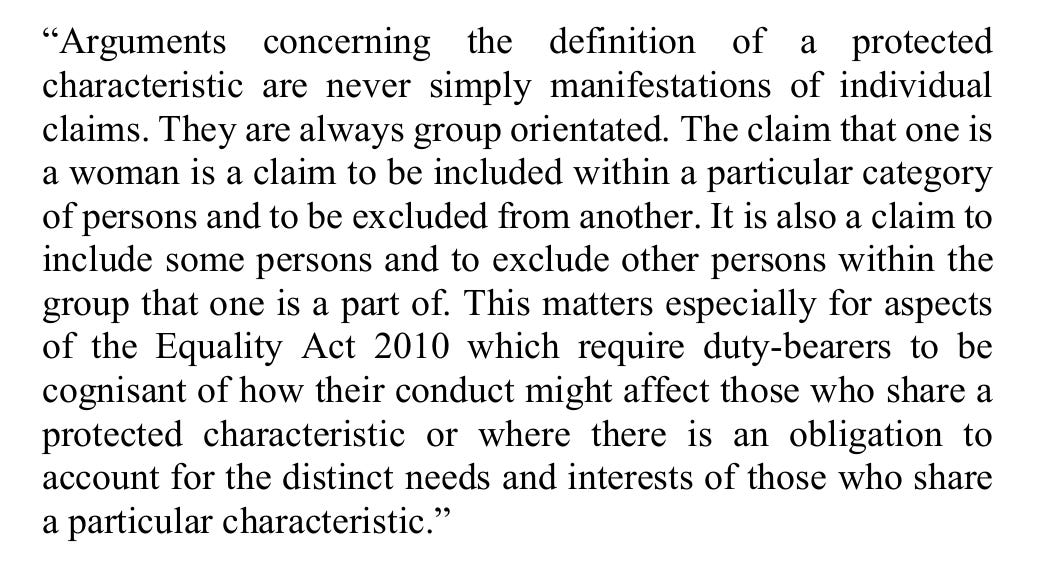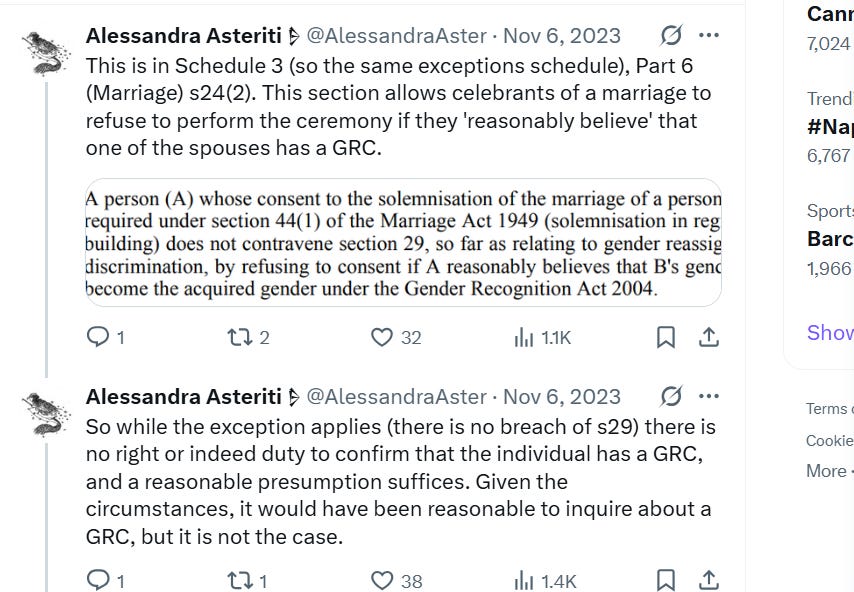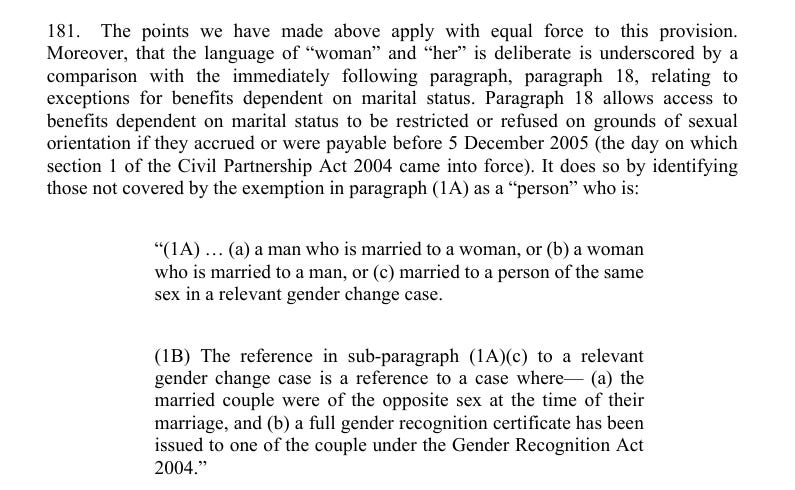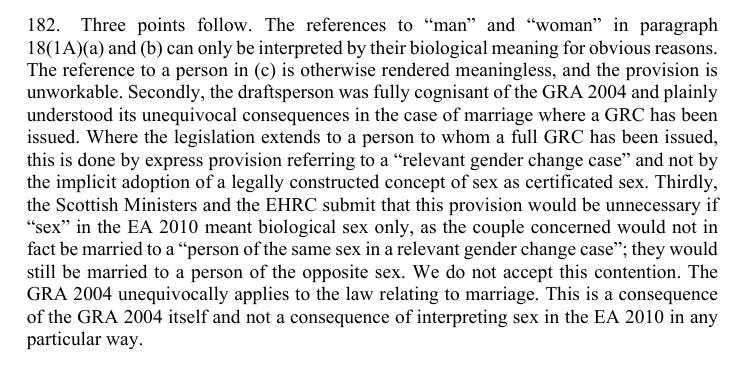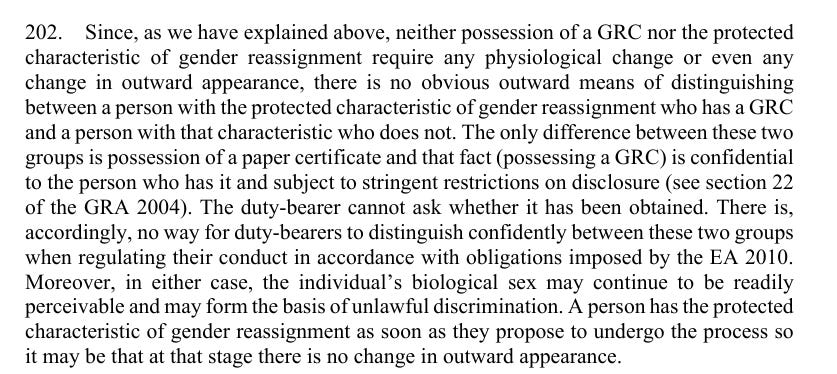Part 5
I am not engaging closely with the section on the interaction between s9(1) and s9(3), except to note that it is unusual, in a case that is mainly about statutory interpretation, that the Court basically ignores s9(2), which is the clause specifically dealing with interpretation (s9(3) deals with application, not interpretation). Here is s9 to show the difference:
S9(3) is a classic conflict rule, determining that s9(1) is disapplied whenever it is required by any other provision in the GRA or in other Acts or subordinate legislation, both preceding and successive, as clarified by the Court (paras 103 ff). I have not come to a conclusive opinion on why the Court ignores s9(2). I note though that the Scottish Government, in its submission to the UKSC did not, as I detailed in this post:
The Court disagrees that s9(3) requires express wording to be engaged (para 102) and I accept this, but still the doubt remains why s9(2) is not part of the analysis at all.
At para 111 the Court reports the contention made by Judge Choudhury in Forstater that refusing to refer to a trans person by their preferred pronoun could constitute harassment, seemingly agreeing with it. This is most inappropriate in the context of this section, where the Court is discussing the effects of GRCs. A “trans person” is a non-existent legal entity. The law recognises people with an acquired gender in possession of a GRC (and members of the public are not necessarily aware of this fact, so this cannot create legal duties for them, let alone transform social niceties such as the use of preferred pronouns into legal duties), and transsexuals with the PC of GR, most of whom do not have a GRC. Why the Court is mudding the waters in such a manner is anyone’s guess, but I cannot say I know who the Court thinks is under a duty to use preferred pronouns in respect to whom.
I am forced here to reinforce the importance of accurate language in this legal issue. “Trans people” do not exist in law and to engender a confusion between holders of GRCs, people under the protected characteristic of Gender Reassignment, and the social category of “trans people” is unhelpful to say the least, and unbecoming of the Supreme Court.
In the section on the EqA the Court provides a detailed summary of the Act’s content and effect. There are some things I want to stress. The Court reviews the issue of comparators for the application of the direct discrimination prohibition. Here is its summary:
It is clear that the comparator works by using the PC as the difference between the claimant (B) and the comparator, be it real or hypothetical. Comparator issues are often wrongly described, the most fanciful description I have seen claiming that B and the comparator have to share all PCs except the one at the basis of the claim, and only my nice nature prevents me from saying here who came up with this absurd interpretation. It is also important to note that GR is a sex neutral characteristic, so the comparator does not need to be of the same sex as B, though it is likely to be in the circumstances. But the Court clearly notes that their sex may well be immaterial to the comparison, again, as I and others and insisted it was the case, against the full force of the GC commentariat.
Next, the Court considers the issue of the protection from discrimination on a group basis. In this context the Court opens with a quote from an article by Michael Foran.
I am not an equality law expert, but it seems to me this analysis is quite superficial in that it ignores that not all protected characteristics work on the same basis, when it comes to considering the collective element of them. There are two kinds of PCs: in the first kind, the characteristic is shared by all. In this group we find race, age, sex, and sexual orientation. All humans possess these PCs, so the groups are within the PC. Within the PC of sex, the most obviously relevant here, there are males and females. Together, they make up 100% of the population. The other characteristics are clearly divided between a group that possesses the relevant characteristic and one that does not. For disability, disabled people possess the relevant PC, non disabled people do not. Same for religion, or marriage/civil partnership, or, indeed, gender reassignment. It is not the time or place here to analyse the historical and theoretical reasons why this is so, but simply to note that sex and gender reassignment also differ in this respect and so any discussion on the relevance of group discrimination has to take this distinction into consideration, in my humble opinion. The argument presented in the article, that PCs create an in-group and an out-group, is, on its own, simply banal. Any word creates a boundary around itself, and PCs could not possibly be any different. Other than that, a woman could claim discrimination even if she was the only female employee, so the group element is not necessary in practice, and in theory, well if a PC was shared only by one individual, it would never have made it as a PC! The argument that there may be specific duties to guarantee substantive equality at a group level simply derives from specific provisions in the EqA (basically, all of Part 11, Advancement of Equality, which clearly, and again, quite banally, concerns groups sharing a PC, and not individuals possessing a PC) where this is spelled out, and, again, do not seem to require a specific insight. It is enough to be able to read s149(1).
It is true that the indirect discrimination test contains a sort of group test, as evident from the language of its provision:
But this is just a theoretical exercise, analogous to the hypothetical comparator test: in order to prove indirect discrimination one needs to prove that B shares a PC that puts him or her at a disadvantage compared to people that do not. This is obvious to the point of banality. There are some problematic element in this exercise, as, as in the examples given, it is not necessarily the characteristic that the group share, but the stereotypes or societal expectations about that characteristic. Sex does not include the caring responsibilities one has. It is the way society is organised that means it is mostly the job of women to shoulder the burden of caring for the young and the old, so it is indeed common that certain shift patterns, prima facie sex neutral, may indirectly discriminate against women. But this is not because women are female, but because society is sexist. And the solution equality law provides is indeed at individual level, not necessarily societal or even group. There are no indirect discrimination group claims, only individual ones.
Provisions to increase representation of under-represented or structurally discriminated groups are qualitatively different and I am afraid the treatment of this topic by the Court unhelpfully conflates these issues and also, at this point, I have lost track of the relevance of this discussion to the issue of the inclusion of GRC holders to the sex class opposite to their birth one. This is how the Court brings us back to the question, to the extent that the reasoning of the Appellants stressed the disadvantage women, and especially certain groups of women, suffered if their group characteristics were ignored.
While this provides a further argument against the inclusion of males with a GRC in the definition of woman in s212, the EqA is not premised on the idea that protection against indirect discrimination only kicks in if an intruder enters the group. Males with a GRC should not be considered women not because women suffer a detriment, but because they are males. Even if women suffered no detriment, they still should not be included. Because they are males. And words, and categories, and reality, matter.
Part 6
With para 155 we arrive at what the Court defines as the central question of this case:
As posed, I have trouble with this question, even though I admit this is not strictly my area so I bow to the Court’s infinitely greater expertise. Nonetheless, I do not think s9(1) applies to all statutes indiscriminately. In my view it applies to displace the birth sex of the GRC holder replacing it with their acquired gender for those legal purposes where sex is confirmed by birth certificate. This is quite a narrow effect, for all the reasons I have already enumerated, so I struggle to agree with the proposition that the EqA would have to make a provision within the meaning of s9(3) to displace the application of s9(1) which would otherwise apply. It also concerns me that, although the Court insisted this is a case of INTERPRETATION, it ignores s9(2), which deals with interpretation, and focuses only on s9(3) which deals with application. Now, to make clear why I find this problematic: s9(1) concerns exclusively GRC holders, a tiny percentage of the population. It beggars belief that the Court considers that s9(1) must apply to the EqA: in its totality? to displace the meaning of sex as biological sex and replace it with the meaning of sex as “certificated sex” in all circumstances? When would s9 apply, if not in the circumstances when it is necessary to apply it, i.e. in the case of people with an acquired gender displacing their birth sex for those purposes where birth certificate sex is relevant?
Additionally, and crucially, and an argument which the Court seems to ignore, the EqA makes an express provision for the application of s9 when it considers it necessary. There are only two circumstances where the EqA mentions GRCs/the GRA, and I have written on this extensively. According to the well known inclusio unius principle of interpretation, if something is expressly mentioned, it applies in that specific circumstance and, e contrario, does not apply when it is not mentioned. To clarify with an example, if the law specifies that under-18s can vote for certain specific elections, it follows that when these are not mentioned, the usual rule that only over-18s can vote applies.
The only two mentions of the GRA are in the Schedules, specifically Schedule 3, Services and public functions exceptions, and Schedule 9, Work exceptions.
This is para 24 of Part 6:
I do not consider any subsequent changes relevant, because here the issue is the intention of the legislators and of the drafters when this paragraph was drafted. You will notice that the “reasonable belief” that a person has a GRC is sufficient to provide a justification for the marriage celebrant not to perform the marriage, as it would effectively be a same sex marriage in the eyes of the celebrant. The reasonable belief suffices as the celebrant is not in the position to inquire about possession of a GRC, I believe. Contrast that with para 18 of Schedule 9:
This paragraph concerns benefits dependent on marital status, extending them to a person who is married to a person who has the acquired gender opposite to his or her sex, thereby applying s9(1). In this case the GRC can be requested by the employer, so it is not a matter of reasonable belief to justify what would otherwise be unlawful discrimination based on GR, but to grant specific benefits dependent not on GR status (unmentioned in the paragraph) but on GRC possession. The EqA drafters seemed to be quite alive to the interaction between GRA and EqA and spelled it out clearly when they deemed it necessary. Now, to clarify, this is not the same thing as the requirement to have an express disapplication of the GRA in the EqA, which in any event the Court did not deem necessary:
In fact it only confirms that express disapplication is not necessary because when the drafters wanted s9 to apply they said so expressly, so the default is that s9 does not apply, not that it is disapplied (a fine but crucial distinction). Indeed the Court does mention para 24 of Schedule 3 (solemnisation of marriage), as well as, later on, para 18 of Schedule 9, although not in detail, but confirming, yet again, an argument that I have been making for years with respect to the interaction between the two Acts:
Incidentally, this proves also that the reasonable presumption that one has a GRC is sufficient in para 24 to provide a lawful exception to the duty of non discrimination. If the drafters intended the GRC to give a prima facie right to be considered as the opposite sex, they would have extended the exception to all services, but they do not, proving that it was already crystal clear to anyone who bothered to consider the EqA in its entirety, that GRCs do not interact, affect or apply to the EqA except when this is expressly mentioned.
The Court also confirms that, contra Lady Haldane, the fact that the EqA does not qualify sex with the adjective biological does not mean it means certificated sex, and vice-versa. I know I am a stickler for details, but this is not 100% correct. The rule in statutory interpretation is that a word retains its plain meaning unless specified otherwise. So not specifying biological sex is not the same as not specifying certificated sex, because biological is the plain meaning of sex, so the default assumption is that it does not need specifying; certificated sex (sic, I do not believe this is a thing, the GRA clearly talks about acquired gender, and the Court has not competence to change the word of an Act) is not the plain meaning, so the default assumption is that it needs to be specified.
The Court quotes approvingly the Forensic Medical Services (Victims of Sexual Offences) (Scotland) Act 2021) as proof that sometimes it is clear that sex means biological sex, but in that specific case, clarity was further provided by the famous Lamont amendment (replacing the original gender with the word sex). Indeed there is no use of the word sex to mean other than biological sex anywhere in the law, to my knowledge. That is because sex only has one meaning, not the four separate ones that originate from this judgment:
sex as biological sex;
sex as certificated sex;
sex as reassigned sex (as per s7 EqA, though the Court interprets this as biological sex);
sex as a matter of law (which I will tackle later).
The Court engages in a “close analysis” of the EqA to ascertain whether s9(3) applies to disapply s9(1) therefore preserving the plain meaning of sex as biological sex (this would not be necessary if the Court did not insist to call acquired gender certificated sex and pretend that there is no difference between not using the word biological and not using the word certificated, as I have already said). The analysis and its conclusions will be the topic of Part 7.
Part 7
In its analysis the Court restricts its own stated scope, which included, in the paragraphs cited, “male” and “female”. As I noted already, had the analysis included these two words, the Judgment would not be so long. Clearly male and female have to have an unambiguous, consistent plain meaning, in order to be used effectively to define man and woman respectively. In fact in paragraph 171 the court comments the word biological does not appear in the Act, but male and female ARE biological terms, referring to the sex distinction common to millions of plant and animal species.
It is true that including men with the acquired gender of female in the female sex class would create a heterogeneous group and render equality law of impossible application. This argument gains semantic strength when you use the proper statutory language and you refer to acquired gender and not certificated sex. I know I am labouring the point but there is no reason why the Court should use the term certificated sex, derived, apparently from the submission by Senior Counsel Aidan O’Neill acting for FWS in the Petition for Judicial Review decided by Lady Haldane in [2022] CSOH 90. O’Neill also argued the change of the wording between the SDA 1975 (woman INCLUDES a female of any age) and the EqA 2010 (woman MEANS a female of any age) is significant, the Court (and myself) disagreeing. Clearly the wording was just designed to clarify that girl is subsumed in the term woman, and boy in the term man, and nothing else. If anything, the EqA more clearly specify that no other individual can be defined as a woman than a female human, juvenile or adult, leaving no room for doubt or ambiguity. Hansard clarifies, in the debates held in the Lords about the Sex Discrimination Bill in 1975, that the clause simply intended to include girls and boys in the words women and men
The relevant clause was so amended, so that the Act clarified that discrimination against boys in educational establishments is unlawful as well, the concern of Lord Gardiner.
I commend the approach of the Court that words are presumed to maintain a consistent meaning in a statutory instrument unless otherwise provided, and the Court considers specifically the section regarding pregnancy discrimination and maternity discrimination to argue that a biological meaning must have been intended. However the word “sex” is used in s7 (Gender Reassignment) as well:
What does sex mean in section 7? If sex means biological sex only, then people with the PC of GR are reassigning their sex from male to female or vice-versa. What effect would this have on their PC of sex? I have already made clear several times in the past that what needs urgent clarification is the meaning of gender (reassignment), not, or not only, of sex. Clearly sex and gender, while being linked in law, not least in the GRA and in GR, are separate entities. And yet neither the GRA nor the EqA provide a workable definition of the term. We are not going to obtain the required clarity until gender is subjected to the same searching analysis that sex was subjected to.
I should note that the Court, just as I have argued repeatedly, states that para 18 of Schedule 9 (Work Exceptions) confirms that the drafters of the EqA were perfectly cognisant of the effects of the GRA on the EqA: this paragraphs concerns marital benefits, as I have already mentioned, and possession of a GRC makes a difference. The Court takes this as indication that when sex is modified by the GRA, the EqA notes this specifically:
I regret to notice that the Court seems to make no distinction between the term exception, the term actually used in the EqA, and the term exemption, which has quite a different meaning in law. It is true that a perusal of the Act shows that actually it would have been better to use both terms, as some of the Schedules contain exemptions, which create a carve-out whereby the law does not apply to the circumstances, and exceptions, where the law remains applicable unless it is proven that the exception applies, including, at times, through a proportionality analysis.
I think the Court is quite correct in rejecting Lady Dorrian’s approach to contextual interpretation, especially, I would add, since she admits in her judgment of being “impractical” to read every section of the EqA to ascertain whether sex is used in its biological meaning or otherwise, so it seems unlikely that the approach she suggests can accomplish, as she claims, clarity:
“What is required is that whenever the phrase or word occurs, its meaning within the particular context where it appears is clear and predictable. The approach which we have identified achieves that.”
Nonetheless, the Court fails to put in context Lady Dorrian’s comment, which is that her case concerned the Representation in Public Boards Act, not the entirety of the EqA, and it would have been inappropriate for her to parse the entire EqA:
I do question the problematisation of a matter that, if one stops using “certificated sex” as an accepted legal term and reverts to the statutory “acquired gender”, does not present excessive difficulty. The GRA and the EqA do not speak of transmen, but of people with an acquired gender modifying their birth sex on their birth certificate (and nowhere else), and people with the protected characteristic of gender reassignment, or transsexuals, respectively. For the purpose of the question posed in the case, a biological woman with the acquired male gender remains, biologically, a woman and therefore protected by the relevant pregnancy and maternity provisions in the EqA. Her acquired gender is relevant in the EqA in para 18 of Schedule 9 and para 24 of Schedule 3. The Court is complicating matters by trying to explain away language that is not present in the statutes it is analysing, where transmen and transwomen do not exist. Additionally, s12 GRA confirms that motherhood and fatherhood are unaffected by one’s acquired gender. If one remains a mother even after having acquired a male gender, one remains a mother for the purpose of maternity protection, quite logically. I do believe this is a case where purposive interpretation has to take precedence over textual interpretation in the interest of guaranteeing the full effect of the Act though also quite clearly s12 GRA is intended more for the protection of the rights of the child than for any non-discrimination protection that might attach to pregnancy and maternity. This is quite patently a case of the drafters of the GRA and EqA never imagining that one day a woman who acquired a GRC committing to live as a man the rest of her natural life would nonetheless become pregnant and birth a child. It is almost painful to see the Court grapple with the absurdity of it all. In any event, it seems to me it would also be possible that the pregnancy and maternity sections in the EqA are “provisions made” for the purpose of s9(3) GRA, so that s9(1) needs to be disapplied in order to avoid the provision being made incoherent or unworkable by the application of s9(1).
In analysing s7, the Court is forced to admit that sex in s7 must necessarily refer to biological sex, but that reassigning one’s (biological) sex does not have an effect on sex as a matter of law (para 200). I am not sure what “sex as a matter of law” means, as opposed biological sex and certificated sex (I am adopting, without approving them, the terms used by the Court). Is certificated sex not sex as a matter of law? Once again, sorry for being insistent, if the Court used the correct legal term, acquired gender, it would not be forced to muddy the waters while trying to explain a section, s7, which suffers from bad drafting and lack of clarity.
This paragraph is of course a common sense interpretation of the lack of effect of the GRC on the protected characteristic of GR. A lot of ink was spilled about this possible effect, arguing that a secret GRC could make the difference in the application of the EqA, including its sex exceptions. The Court disposes of this argument, brought forward by many GC lawyers as well, in a single paragraph:
The interpretation of sex to “always” include acquired gender would of course lead to absurd results, as the Court pithily notes with respect to sexual orientation:
I think one of the issues though is that Lady Dorrian is addressing the law as it is, while the Court is taking on board the submissions of the interveners for FWS on the effect of unlawful policies that misinterpret the law. This is particularly clear in the paragraph on sexual orientation, where Lady Dorrian seems bemused by the suggestion that someone would claim to be a lesbian because he had a GRC in the acquired female gender
Here she also seems to ignore that a GRC does precisely that, and was intended to do so, by creating the legal fiction of “opposite sex marriage” for two gay men, one of whom had a GRC in the female acquired gender. So while sticking to the law, she ignores that the law already did allow the change of one’s sexual orientation on acquiring a GRC, and was in fact the main justification for introducing the GRA. I cannot escape the feeling that Lady Dorrian wanted to avoid the most controversial aspects of this legal issues, and so she hid behind judicial economy to restrict her judgment to the effect of the GRA on the Scottish Act.
In the next part, I will analyse the Court’s treatment of the sex exceptions, which find the most problematic section of the judgment.










